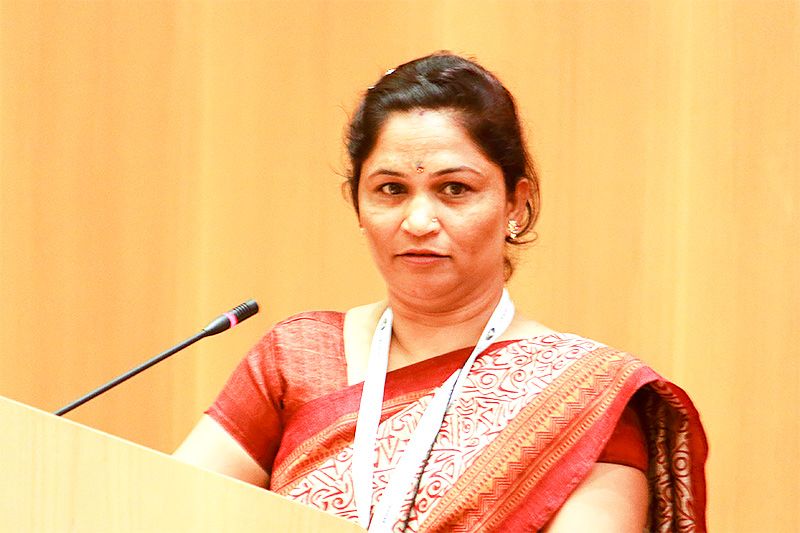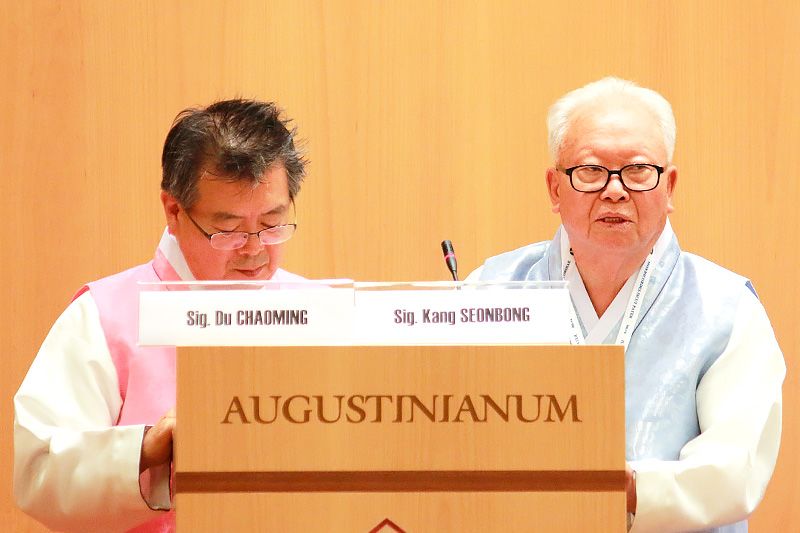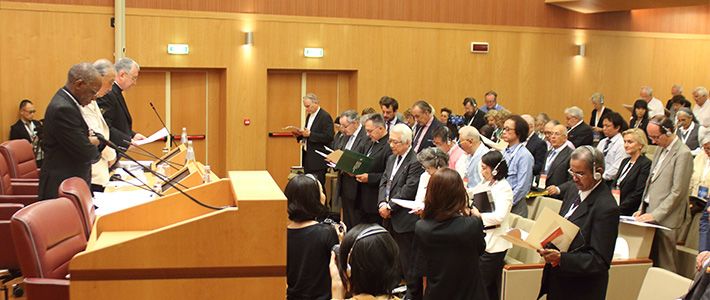
Promoting Inclusion of People with Hansen’s Disease
Toward a Stigma-Free World
Politics Society- English
- 日本語
- 简体字
- 繁體字
- Français
- Español
- العربية
- Русский
On June 9–10, 2016, the Vatican hosted its first-ever international symposium on Hansen’s disease. The conference was held as part of the Catholic Church’s jubilee events for the ill and disabled during the Holy Year of Mercy, which began in December 2015 and will continue through November 2016. The symposium, titled “Towards Holistic Care for People with Hansen’s Disease: Respectful of Their Dignity,” was organized by the Pontifical Council for Health Care Workers and the Nippon Foundation.
Eliminating Lingering Stigmas
The symposium’s Conclusions and Recommendations summarizing the comments and discussions during the meeting note that “grave forms of discrimination” continue to exist in society and that the human rights of people affected by Hansen’s disease and their families are not being upheld. The document calls on governments and social and religious institutions to ensure that the Principles and Guidelines for the Elimination of Discrimination against Persons Affected by Leprosy and their Family Members—adopted in 2010 by the United Nations Human Rights Council—become operational at a practical level, noting that the “repeal of discriminatory laws is very urgent and can no longer be postponed.”
The Conclusions and Recommendations also invite religious leaders and their communities “to transmit respect for people with leprosy” and ensure that such efforts are based on the opinions of the affected persons themselves.
The active involvement of religious communities, including the Catholic Church, would help eliminate the lingering stigmas, which are “often associated with a religious vision of life.” Recommendations were also made for a new language when speaking about Hansen’s disease, as discrimination and old perceptions continue to be reinforced by such “offensive” terms as leper.
The Conclusions and Recommendations are expected to become the guidelines for action for Catholics worldwide—especially in Africa and South America, which have sizable Catholic populations—on the issue of eradicating discrimination against people with Hansen’s disease.
Correcting Mistaken Beliefs
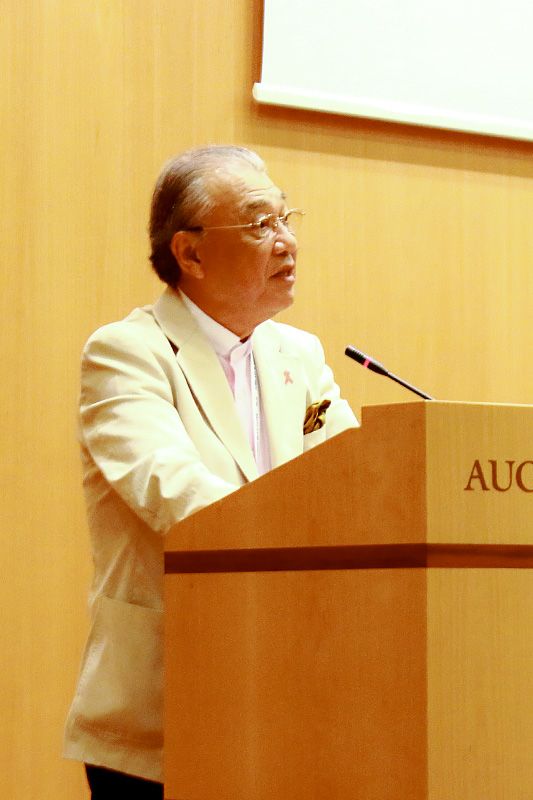 Nippon Foundation Chairman Sasakawa delivering the opening remarks.
Nippon Foundation Chairman Sasakawa delivering the opening remarks.
The symposium’s opening remarks were delivered by Nippon Foundation Chairman Sasakawa Yōhei, who is also the World Health Organization’s goodwill ambassador for leprosy elimination. “Hansen’s disease can now be cured with proper treatment, but there are still some people who mistakenly believe that it is God’s punishment,” he commented in calling for a fuller understanding of the ailment.
Erwin Cooreman, team leader of the WHO’s Global Leprosy Program, reported that as multidrug therapy became the standard form of treatment, the number of leprosy patients declined dramatically, falling by 90% in just 15 years between 1985 and 2000. This helped to achieve the WHO goal of eliminating the disease as a public health problem—defined as reducing the number of leprosy cases to less than 1 per 10,000 population. Elimination strategies have now shifted from national-level programs to the regional and community levels.
Yokota Yōzō, president of the Center for Human Rights Education and Training in Japan, who authored the 2005 report on leprosy-related human rights issues by the United Nations Commission on Human Rights, cited specific examples of discrimination against patients and their families, saying that “especially grave . . . violations of the rights of people affected by leprosy [were] in the field of instruction, work, and marriage.”
Presentations by Recovered Patients
Also making presentations were recovered Hansen’s disease patients, who recounted the discrimination and prejudice to which they were subjected.
Valdenora de Cruz Rodriguez, who now helps recovered patients return to their communities and regain their rights in Brazil, developed symptoms at age 8 and was sent to a hospital in a remote colony when she was 9. She was refused a ride on the steamship to the colony, though, and was placed on a small boat attached to the ship. She left the hospital and returned home when she was 16 but became the target of ungrounded castigation, forcing her to move back to the colony. The anguish she experienced at the time became the driving force for her subsequent social activities.
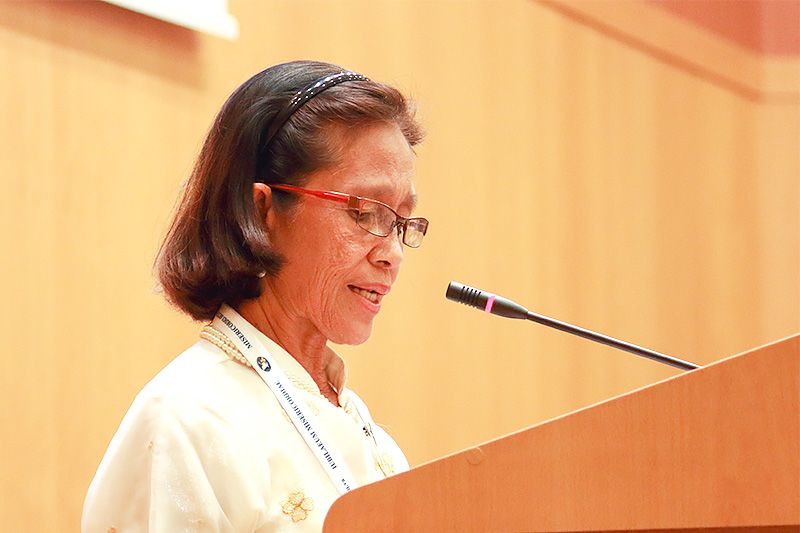 Recovered patients (top to bottom) from India, South Korea, and the Philippines make presentations at the symposium.
Recovered patients (top to bottom) from India, South Korea, and the Philippines make presentations at the symposium.
After recovering, Yuan Yafua of China initially became a care worker and then a maker of prosthetic legs. He joined a nongovernmental organization in Guangzhou that supports Hansen’s disease patients and now travels to various parts of the country to make legs for those who have lost their limbs. His inspiring report was met with warm applause.
The speaker from Japan was Ishida Masao, vice-chairman of the residents’ organization at the National Sanatorium Nagashima Aiseien in Okayama Prefecture. He became infected when he was 10 years old and moved to the sanatorium, where he has lived for the past 70 years. He talked about this life there, including the years immediately following World War II when the discovery of the drug promin kindled a desire to once again “live like human beings,” leading to hunger strikes, sit-ins, and other organized protests by patients calling for the abolition of Japan’s forced isolation policy and the restoration of human rights.
 Ishida Masao recounts his experiences at the Nagashima Aiseien sanatorium.
Ishida Masao recounts his experiences at the Nagashima Aiseien sanatorium.
He also noted that many school students who study the history of the disease now have a more accurate understanding of the malady than adults, who continue to harbor prejudices. Ishida described the efforts now underway to register the 13 national sanatoriums and their cruel history of discrimination as World Heritage sites and to turn Nagashima into an “island of human rights.”
(Originally written in Japanese by Ishii Masato of Nippon.com and published on June 14, 2016. Banner photo: Participants offer a prayer at the start of the June symposium on Hansen’s disease at the Vatican.)Nippon Foundation human rights leprosy Hansen’s Disease Vatican
